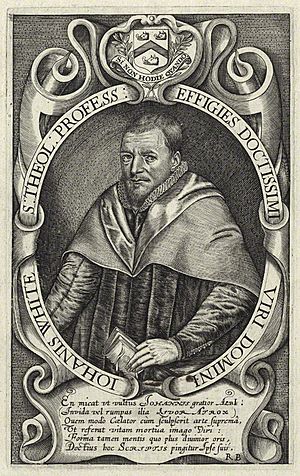John White (chaplain) facts for kids
John White (1570–1615) was an important English clergyman, which means he was a leader in the church. He was also known as a royal chaplain, serving the king, and a controversialist. This means he often took part in debates about religious ideas.
Contents
About John White
Early Life and Education
John White was born in Eaton Socon, a village in England, around 1570. His father, Peter White, was a vicar, a type of church minister. John had a brother named Francis White, who later became a bishop.
John went to St. Neots grammar school. He then studied at Gonville and Caius College, Cambridge, starting in 1586. He earned his first degree, a Bachelor of Arts (B.A.), in 1590. He continued his studies, getting his Master of Arts (M.A.) in 1593 and a Doctor of Divinity (D.D.) in 1612.
His Career as a Clergyman
After his studies, John White became a vicar in Leyland, then in Eccles, both in Lancashire. In 1606, he also became a fellow at the Collegiate Church, Manchester.
In 1609, he moved to Suffolk. There, he became the rector of Barsham church. A rector is another type of church minister. Around 1614 or 1615, he was made a chaplain to King James I. This was a special role, advising the king on religious matters.
His Later Years
John White passed away in London in 1615, when he was about 45 years old. He was buried at St Mary Woolnoth church. He had seven children. His oldest son, also named John, followed in his footsteps. He studied at the same college and became a vicar in Eaton Socon, his father's hometown.
His Writings and Debates
John White was known for his strong religious beliefs. He wrote several books and sermons. His most famous work was The Way to the True Church. It was published in London in 1608.
The Way to the True Church
This book was written to defend Reformed theology. This was a branch of Protestant Christianity. White's book argued against the ideas of John Percy, a Jesuit priest. Jesuits were members of a Catholic religious order. Percy had written a book called Treatise of Faith.
White's book started a big debate. Many people read it, and new versions were printed in 1610, 1612, and 1616. Other writers, like Anthony Wotton, also joined the discussion.
The Religious Debates
John Percy replied to White's book with his own work in 1612. White then wrote A Defence of the Way to the True Church in 1614. This book was his answer to Percy.
Other writers also joined the debate. William Wright wrote a book criticizing White's work in 1619. Another writer, Thomas Worthington, also wrote against White's book in 1615. After John White died, his brother Francis wrote a reply to Worthington in 1617.
Local Beliefs and Superstitions
In The Way to the True Church, John White also wrote about local customs. He described what he saw as superstitious beliefs in Eccles, where he had been a vicar. He thought these beliefs were still influenced by Catholic priests. This was because many people in that area were still Catholic.
Other Published Works
John White also published other religious texts:
- English Paradise, a sermon based on a Bible verse, published in 1612.
- Two Sermons, which included a sermon given at Paul's Cross, published in 1615.
After John White's death, his brother Francis collected all his works. He published them together in one large book in 1624.


